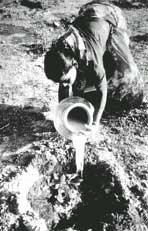Woods for women
 how does one judge the success of a forestry project? By the sight of trees on the land and equally importantly by the fact that they have been raised by poor rural women. To us at Self Employed Women's Association ( sewa ) (an Ahmedabad-based voluntary organisation), these are the twin criteria which reflect our achievements in the forestry sector, which involves the efforts of a third of our 213,000 women members. They not only ensure the preservation of forests but also provide sustenance to the women who nurture them. Unless and until the planting of trees generates income for poor rural women, forestry will not take off in India. This is a lesson that has assumed national importance.
how does one judge the success of a forestry project? By the sight of trees on the land and equally importantly by the fact that they have been raised by poor rural women. To us at Self Employed Women's Association ( sewa ) (an Ahmedabad-based voluntary organisation), these are the twin criteria which reflect our achievements in the forestry sector, which involves the efforts of a third of our 213,000 women members. They not only ensure the preservation of forests but also provide sustenance to the women who nurture them. Unless and until the planting of trees generates income for poor rural women, forestry will not take off in India. This is a lesson that has assumed national importance.
The global lesson that sewa seeks to emphasise is the fact that global finance and forestry are concerns that cannot remain isolated or divorced. Although sewa 's exposure to and understanding of international trade and investment treaties is not adequate, we can all the same observe their impact at the grassroots level. Their effects have for the most been harsh on the ecology and economy of the women's families as they have affected their access to local natural resources. Global rules governing investments are being worked out under the Multilateral Agreement on Investment ( mai ), to enhance the efficiency of global investment flows and provide a level ground for investors across countries. We at sewa demand that the mai in India include, firstly, a way of mitigating the adverse impact of such investments on the poor rural woman's access to natural resources, including forests and; secondly, that such investments try and enhance the availability of forests for these women, wherever possible.
In addition, we also demand a joint forestry model in which roles would be reversed. So far, the state has owned the land and the poor have toiled on it by planting and nurturing the trees on it. I would like the situation to change into one wherein poor rural women own the plots and the state forestry department provides them with technical and professional services as and when they require the same. In fact, the land in question could even be private marginal plots. By doing so, we could switch from supply to demand driven forestry. But the demand must necessarily be placed by poor women for only then can we judge the true nature of the market.
Moreover, we need to think comparatively since the experiences of different regions are bound to vary. We must be able to transmit our knowledge, action and solutions from one place to another, be it from Gujarat to Bihar or from Orissa to Himachal Pradesh. Such transfer of knowledge and experience should be achieved directly and not through academic programmes or government schemes. The logic and habit of universalising forestry related problems and solutions must end. As far as the forestry sector is concerned, we should confront the particularities of the context in which rural women live and work.
Related Content
- Biogas for domestic cooking
- Women cooking with biomass fuels more likely to have cataracts
- Status and trends in traditional occupations: outcomes of a rapid assessment
- Impacts of small-scale electricity systems: a study of rural communities in India and Nepal
- Why sustainable energy matters to Children: the critical importance of sustainable energy for children and future generations
- Rural women can play crucial role in tackling climate change
